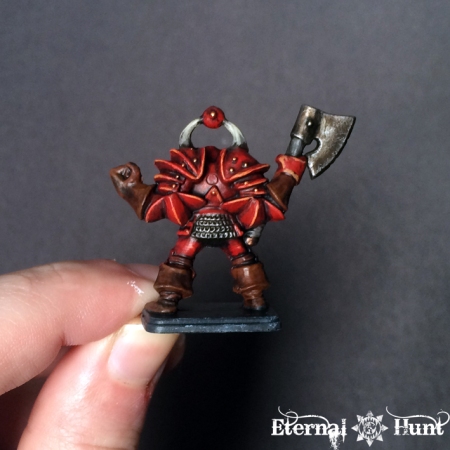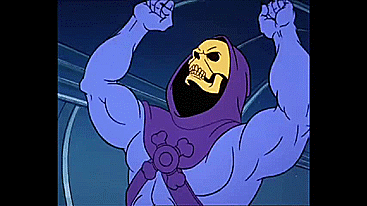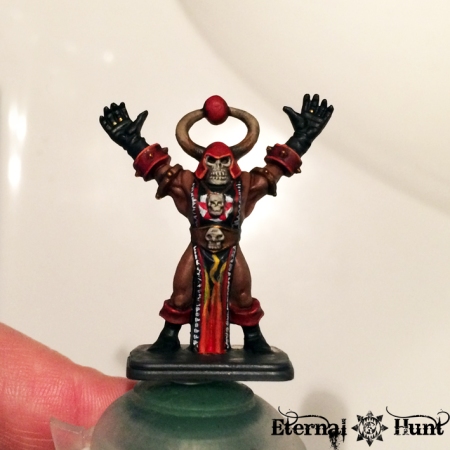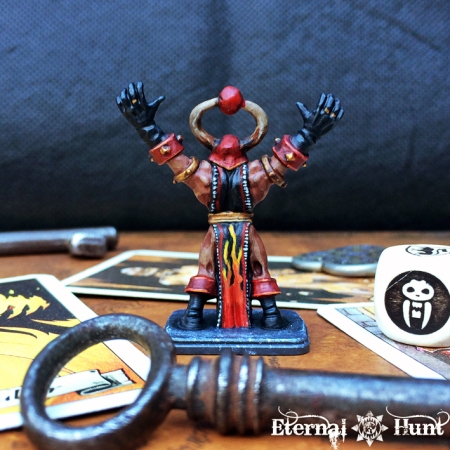In a way, all of the greenskins and undead I have painted for my #HeroQuest2019 project so far have mostly been a preparation for the models I want to share with you in today’s post — because even back when I got my first HeroQuest set, I immediately fell in love with the chaos models above all others: This was basically my very first contact with GW’s approach to the forces of chaos, but even back then, the faceless, armoured menace of the HeroQuest chaos warriors deeply appealed to me — and with long lasting consequences, arguably, because I am still a fan of heavily armoured, spiky chaos models to this very day!
So I wanted to do the chaos warrior models justice, but I was also slightly nervous about coming up with the right recipe for them. And there was also another problem, one that becomes obvious when you take a look at the chaos warriors appearing in this picture:
Yes, two of them had already been painted previously — and quite horribly so, to be honest: The first model was caked in an absolutely atrocious paintjob that mostly consisted of a thick coat of Blood Red, slathered over an even thicker undercoat of the old white GW primer. Even with several scrubbing sessions, I wasn’t able to completely strip off the paint, so I feared he would never exactly be a beauty again:
Case in point, there was even a weird lump on his left shoulder that didn’t match the look of the other chaos warriors, and only after some prying with a hobby knife did I discover that it was an ancient lump of superglue… Oh well… 
His buddy, on the other hand, seemed like he would be less of a problem, because old his paintjob was a lot thinner — it consisted of hard to remove scale model acrylics, though, so even after stripping, there was still some black on him:
…So these two were the models I started with. Here’s another look at them, next to an old plastic WFB/Talisman chaos warrior whom I may use to represent the named chaos warriors that appear in some of the quests. Since he already looks like a slightly upgraded version of the HeroQuest models anyway, this seems like a pretty sound approach (as an aside, I still have an entire squad of those old plastic warriors that forms a part of my very first WFB chaos army):
So it was clear that I would start with the more damaged of the two chaos warriors as my guinea pig, because there was simply a lot less left to lose with that – already pretty rough – model. But still, the question remained: What recipe was I to use for my HeroQuest chaos warriors?
My first point of reference was to take a look at the classic Mike McVey paintjob from back in the day:
But it didn’t take me long to realise that this approach wouldn’t work for me: I am no Mike McVey, for one, and wasn’t sure I would be able to reproduce all of the tiny patterns and detail you can see in the model above — and I also have to admit that the finished look seemed just a bit too trippy and artistic to me — I was looking for something a little more down to earth for my own models.
Another approach that I had seen fellow hobbyists use was to paint each of the four chaos warriors as a follower of one of the four chaos gods, respectively. This seemed like such a cool idea, and I really thought about it for quite a while. In the end, however, I really wanted the four models to work as a massive, unified block of inhuman, armoured malice, and having them in all colours of the rainbow would have worked against that intended effect.
So I went back to the other obvious reference material: The chaos warrior monster card included in the game itself:
Now this seemed quite a bit closer to home — and it would also have the added benefit of perfectly matching GW’s classic “Red Period” for chaos models.
So here’s how my first test model turned out:
GW’s modern red hues look great when layered on top of one another, so they also worked like a charm when highlighting the armour. I was basically able to use a variant of Duncan Rhodes’ Bloodthirster recipe (which I also used to paint my own Bloodthirster and Daemon Primarch Angron conversion, respectively.)
The sculpt itself helped a lot, as well — in fact, it feels like those old HeroQuest chaos warriors were basically invented to teach people how to edge-highlight armour plates. Granted, the results are still not quite as tidy and clean as I would have liked, but I was still really happy with the finished piece — and all on a model that had seemed like a total loss beforehand, no less! 
So I quickly painted the second chaos warrior in line, the one that had previously been painted black all over:
Things got even easier afterwards, because the remaining two chaos warriors were still pristine and didn’t require any salvage operations. So it didn’t take me long to finish the entire set of four chaos warriors:
So with the success of finishing the chaos warriors still fresh on my mind, I turned to the model I actually feared the most: The Chaos Warlock:
The Gargoyle may be the showiest, biggest and most complex monster in the HeroQuest box, but I think I like the Chaos Warlock even better — again, I blame being a huge fan of Skeletor during my childhood. But even from a modern perspective, I think it’s one of the most interesting models in the box, and one that hasn’t really been superseded by flashier, subsequent Warhammer releases. There’s also the iconic pose — anyway, to make a long story short, I think the Warlock is the coolest model in the entire HeroQuest box, period.
Unfortunately, he was also always and, invariably, the first model to be lost for good. I have actually managed to lose two of those over the years — I distinctly remember painting one of them about about 25 years ago, it was even the first model I ever used actual Citadel Paints on, incidentally. But it’s nowhere to be found today, probably lost at the bottom of a moving box in the attic or basement…
So I was really lucky when, back in 2013, fellow hobbyist (and grimdark impresario) Alexander Winberg was awesome enough to send me an extra chaos warlock — and after the model had been part of my to-do pile for more than five years, I felt it was finally time to get it painted at long last, nervous though I was about the prospect…
Once again, I first looked at the classic McVey paintjob:
And even after doing quite a bit of research, this was where I ended back up — it’s just the most inconic way of painting this model, and the one that seems to work best (unless you are going for a direct copy of Filmation Skeletor’s look):
So for once, I would try to approximate a McVey paintjob directly — no small feat, certainly…
Another point of reference that helped immensely during the painting process was RemyT’s warlock (his are probably the best-painted HeroQuest models in existence), and his version actually used the plastic model, and not the metal pre-production prototype, which definitely helped.
Anyway, I had to cheat a bit here and there, suggesting detail instead of actually perfectly painting it, but I quickly felt like I was actually on to something:
The whole exercise actually gave me a whole new appreciation for Mike McVey’s and RemyT’s respective paintjobs, simply because they have managed to feature so much detail in so very little space. I did the best I could to replicate the look, but like I said, some of the more intricate patterns and effects are suggested, rather than cleanly painted (those tiny white triangles on the robe get less and less convincing the closer you look, for instance). I also left out some of the most delicate wrinkles and squiggles from the reference material, mostly because it felt like taking the model even further would have meant pushing my luck and risking a paintjob I was already really happy with…
That said, my paintjob basically shows off the maximum of detail I could safely pull off, within the limits of my abilities as a miniature painter. Like I said, I was really nervous about this particular model, and I would argue I have managed to do it justice, at least to the best of my abilities.
So here’s the finished piece:
In spite of not achieving the exact same level of detail visible on Mike McVey’s and Remy’s models, I am still really, really proud of the finished model, if I do say so myself: Finally having painted the warlock to this standard was one of the moments I was really looking forward to when I started this model!
So, in closing, let us take a look at “Team Chaos” as it stands right now:
And with that, we are done for today. I would love to hear what you think, of course, so feel free to leave a comment! And, as always, thanks for looking and stay tuned for more! 

















